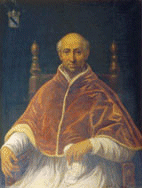1342 papal conclave
The 1342 papal conclave (5 May to 7 May) – the papal conclave convened after the death of Pope Benedict XII, it elected Cardinal Pierre Roger, who became the fourth Pope of the period of Avignon Papacy under the name Clement VI.
| Papal conclave May 1342 | |
|---|---|
| Dates and location | |
| 5–7 May 1342 Palais des Papes, Avignon | |
| Key officials | |
| Dean | Pierre Desprès |
| Camerlengo | Gasbert de Valle |
| Protopriest | Imbert Dupuis |
| Protodeacon | Raymond Guillaume des Farges |
| Elected pope | |
| Pierre Roger Name taken: Clement VI | |
 | |
Cardinal electors
Pope Benedict XII died at Avignon on 25 April 1342. At the time of his death, there were nineteen Cardinals in the Sacred College, of whom seventeen participated in the subsequent conclave:[1]
| Elector | Title | Elevated | Elevator | Notes[2] |
|---|---|---|---|---|
| Pierre Desprès | Bishop of Palestrina | 20 December 1320 | John XXII | Dean of the Sacred College of Cardinals; Vice-Chancellor of the Holy Roman Church |
| Bertrand du Pouget | Bishop of Ostia e Velletri | 17 December 1316 | John XXII | nephew of John XXII |
| Jean-Raymond de Comminges | Bishop of Porto e Santa Rufina | 18 December 1327 | John XXII | |
| Annibaldo di Ceccano | Bishop of Frascati | 18 December 1327 | John XXII | |
| Pedro Gómez de Barroso | Bishop of Sabina | 18 December 1327 | John XXII | |
| Imbert du Puy | Priest of SS. XII Apostoli | 18 December 1327 | John XXII | Protopriest and Camerlengo of the Sacred College of Cardinals nephew of John XXII |
| Hélie de Talleyrand-Périgord | Priest of S. Pietro in Vincoli | 25 May 1331 | John XXII | Cardinal-protector of the Order of Franciscans |
| Pierre Bertrand | Priest of S. Clemente | 20 December 1331 | John XXII | |
| Gozzio Battaglia | Priest of S. Prisca | December 18, 1338 | Benedict XII | |
| Bertrand de Déaulx | Priest of S. Marco | 18 December 1338 | Benedict XII | |
| Pierre Roger, O.S.B. | Priest of SS. Nereo ed Achilleo | 18 December 1338 | Benedict XII | Elected Pope Clement VI |
| Guillaume Court, O.Cist. | Priest of SS. IV Coronati | 18 December 1338 | Benedict XII | nephew of John XXII |
| Bernard d’Albi | Priest of S. Ciriaco alle Terme | 18 December 1338 | Benedict XII | |
| Guillaume d'Aure, O.S.B. | Priest of S. Stefano al Monte Celio | January 1339 | Benedict XII | |
| Raymond Guillaume des Farges | Deacon of S. Maria Nuova | 19 December 1310 | Clement V | Protodeacon of the Sacred College of Cardinals; nephew of John XXII |
| Gaillard de la Mothe | Deacon of S. Lucia in Silice | 17 December 1316 | John XXII | |
| Giovanni Colonna | Deacon of S. Angelo in Pescheria | 18 December 1327 | John XXII |
Ten electors were creatures of John XXII, six of Benedict XII and one of Clement V. Thirteen of them were French, three Italian and one Spanish.
The post of the Camerlengo of the Holy Roman Church was occupied at that time by Gasbert de Valle,[3] Archbishop of Narbonne (not a Cardinal) and nephew of Pope John XXII.
Absentee cardinals
Two French Cardinals, both elevated by John XXII, did not participate in this conclave:[1]
| Elector | Cardinalatial Title | Elevated | Elevator | Notes[2] |
|---|---|---|---|---|
| Gauscelin de Jean | Bishop of Albano | December 17, 1316 | John XXII | Grand penitentiary; nephew of John XXII |
| Bertrand de Montfavez | Deacon of S. Maria in Aquiro | December 17, 1316 | John XXII | Archpriest of the patriarchal Lateran Basilica |
The election of Pope Clement VI
The conclave started on May 5 and lasted only two days. On May 7 Cardinal Pierre Roger, former Chancellor of the Kingdom of France, was unanimously elected Pope, "by divine inspiration alone", as reported shortly thereafter Cardinals des Farges and Ceccano.[4] Elect took the name of Clement VI. On May 19 new Pope was crowned in the church of the Dominicans in Avignon by Raymond Guillaume des Farges, protodeacon of S. Maria Nuova.[5]
Shortly after the death of Benedict XII king Philip VI of France sent to Avignon his eldest son with the task to support the candidature of Cardinal Roger, but when he arrived, the election had been already accomplished with the result expected by the king.[4]
Notes
- Miranda, Salvador. "Conclave of May 5 - 7, 1342 (Clement VI)". The Cardinals of the Holy Roman Church. Florida International University.
- Notes according to the biographical entries of the respective cardinals on The Cardinals of the Holy Roman Church: Consistories for the creation of Cardinals, 14th Century (1303-1404) by Salvador Miranda
- Niccolò del Re, La Curia romana: lineamenti storico giuridici, Città del Vaticano, 1998, p. 296
- G. Mollat, p. 37
- S. Miranda: Cardinal Pierre Roger (Pope Clement VI)
Sources
- List of participants of the conclave of 1342 by Salvador Miranda
- G. Mollat "The Popes at Avignon 1305-1378", London 1963
- Wrigley, J.E. 1982. "The Conclave and the Electors of 1342". Archivum Historiae Pontificiae Roma, 20: 51-81.